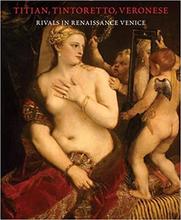More about Mars and Venus United by Love
- All
- Info
- Shop

Contributor
Veronese's Mars and Venus United by Love, like many old paintings, has other names, including Mars and Venus Bound by Cupid, and Mars, Venus, and Cupid.
Mars and Venus Bound by Cupid was the title published in the bulletin of the Met in 1911. The Met still owns the painting, but at some point they cut the little archer cherub from the title and replaced his name with the word Love. Why did Cupid lose his billing? Did he talk back?
One of the best things about reading art history is the ready-made army of euphemisms the writers use to describe things. They often resort to Latin, going into the bedrooms of those unrestrained Romans and their language, now used only in churches and classrooms. You might say they "romanticize" the Roman empire, as if it was an egalitarian place free of bloodsport. Examining layers and layers of paint with composite radiography in order to find a scientifically objective interpretation of the metaphors in the painting, which is already a special brand of wild goose chase, a team of writers find that, awkwardly, the pose of Venus expressing milk from her areola, unlike other major details in the figures of the painting, belongs to all of the layers of paint. In other words, Veronese had his eyes on the prize from the get-go: like it or not, this painting was always going to feature a Roman goddess squirting milk with her hand. The writers' Latin euphemism? "The unusual motif of Venus lactans."
Even the poet Robert Watson is shocked by the squirting milk and the situation between Mars and Venus:
"How can you call these Gods? I think,
Old Master, your painting lewd."
But Watson's conclusion sounds a lot more insightful than the other writers. Reading Mars and Venus from a mystical perspective, Watson says that Venus knows that Mars, no matter how much he loves her, cannot mate with her to summon new life, because he is the God of war, both in Vedanta and in Roman religion, and his horse is there to carry him off to destroy himself on the battlefield. A little cherub is restraining the horse with a sword.
Before they adopted Christianity, the Romans were polytheists: like most other societies, they worshipped many different Gods and Goddesses, including Mars and Venus, who were also astrological and astronomical figures. Gods were important, but for the most part (until the emperors got really godlike, at least) they were trumped by Goddesses, because not everyone has a dad, but everyone has a mommy. And, besides giving birth, what could be more mommy-like than expressing breast milk?
Historians do not know who the original patron was, but they guess it could have been "Holy" Roman Emperor Maximilian II, who commissioned truly bizarre Arcimboldos, also heavily laden with pagan meaning, in order to illustrate the power of his regime. Veronese might have been distracted or in a big hurry during this one, or else he was making a surrealist statement by painting only three legs on the horse.
The shock and puzzlement of critics toward the painting's symbolism shows that they mostly just don't want to see that this is an explicitly sensual, European, pagan, spiritually anti-Biblical work. This is awkward evidence that all those guys who went out and colonized everybody else were themselves worshipping breastmilk a few generations before deciding that the King James Version gave them the divine obligation to hurt people.
Sources
- Burroughs, Bryson. "Ruskin's Tintoretto." The Metropolitan Museum of Art Bulletin 6, No. 1 (Jan., 1911): 6-9.
- Mahon, Dorothy, Silvia A. Centeno, Mark T. Wypyski, Xavier F. Salomon, and Andrea Bayer. 'Technical study of three allegorical paintings by Paolo Veronese: “The Choice between Virtue and Vice, Wisdom and Strength,” and “Mars and Venus United by Love”.' Me
- Rachlin, Harvey. Scandals, Vandals, and da Vincis: A Gallery of Remarkable Art Tales. New York: Penguin, 2006.
- Watson, Robert. Robert Watson: The Complete Poems. Greensboro, NC: Robert Watson, 2011.
Featured Content
Here is what Wikipedia says about Venus and Mars (Veronese)
Venus and Mars is an oil painting on canvas painted in the 1570s by the Italian Renaissance artist Paolo Veronese.
The painting was commissioned by Emperor Rudolph and was one of three mythological and love-themed works commissioned by the artist. The other two are at the Frick Collection in New York: The Allegory of Virtue and Performance and Allegory of the Source of Wisdom and Power. It deals with the romantic love of the Roman goddess of love Venus and the god of war Mars, as described in Ovid's Metamorphoses.
Check out the full Wikipedia article about Venus and Mars (Veronese)













